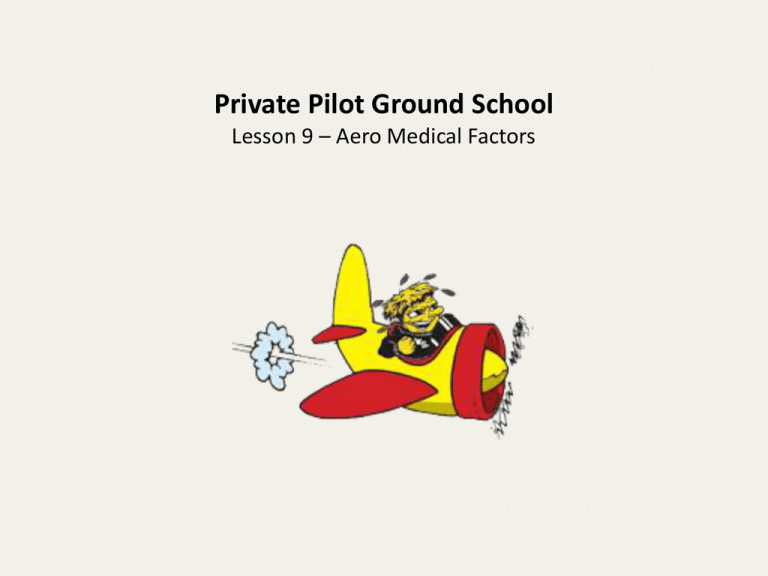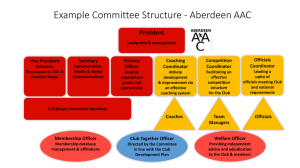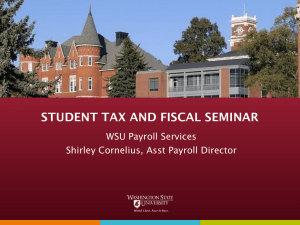Private Pilot Ground School
advertisement

Private Pilot Ground School Lesson 9 – Aero Medical Factors With respect to the certification of aircraft, which is a category of aircraft? C.) Normal, utility, acrobatic. WSU Flying Club – Private Pilot Ground School Lesson 8 With respect to the certification of aircraft, which is a class of aircraft? C.) Airplane, rotorcraft, glider, balloon. WSU Flying Club – Private Pilot Ground School Lesson 8 After takeoff, which airspeed would the pilot use to gain the most altitude in a given period of time? A.) VY WSU Flying Club – Private Pilot Ground School Lesson 8 Which would provide the greatest gain in altitude in the shortest distance during climb after takeoff? A.) VX WSU Flying Club – Private Pilot Ground School Lesson 8 VNO is defined as the C.) maximum structural cruising speed WSU Flying Club – Private Pilot Ground School Lesson 8 With respect to the certification of airmen, which is a category of aircraft? B.) Airplane, rotorcraft, glider, lighter-than-air. WSU Flying Club – Private Pilot Ground School Lesson 8 With respect to the certification of airmen, which is a Class of aircraft? C.) Single-engine land and sea, multiengine land and sea. WSU Flying Club – Private Pilot Ground School Lesson 8 Which V-speed represents maximum landing gear extended speed? A.) VLE. WSU Flying Club – Private Pilot Ground School Lesson 8 Which V-speed represents maneuvering speed? A.) VA WSU Flying Club – Private Pilot Ground School Lesson 8 Which V-speed represents maximum flap extended speed? A.) VFE. WSU Flying Club – Private Pilot Ground School Lesson 8 VSO is defined as the B.) stalling speed or minimum steady flight speed in the landing configuration.. WSU Flying Club – Private Pilot Ground School Lesson 8 The definition of nighttime is C.) the time between the end of evening civil twilight and the beginning of morning civil twilight. WSU Flying Club – Private Pilot Ground School Lesson 8 Each person who holds a pilot certificate or a medical certificate shall present it for inspection upon the request of the Administrator, the National Transportation Safety Board, or any A.) federal, state, or local law enforcement officer. WSU Flying Club – Private Pilot Ground School Lesson 8 The takeoffs and landings required to meet the recency of experience requirements for carrying passengers in a tailwheel airplane C.) must be to a full stop. WSU Flying Club – Private Pilot Ground School Lesson 8 To act as pilot in command of an aircraft carrying passengers, a pilot must show by logbook endorsement the satisfactory completion of a flight review or completion of a pilot proficiency check within the preceding A.) 24 calendar months. WSU Flying Club – Private Pilot Ground School Lesson 8 If recency of experience requirements for night flight are not met and official sunset is 1830, the latest time passengers may be carried is A.) 1929. WSU Flying Club – Private Pilot Ground School Lesson 8 Each recreational or private pilot is required to have C.) a biennial flight review. WSU Flying Club – Private Pilot Ground School Lesson 8 A third-class medical certificate was issued to a 19-year-old pilot on August 10, this year. To exercise the privileges of a recreational or private pilot certificate, the medical certificate will expire at midnight on C.) August 31, 5 years later. WSU Flying Club – Private Pilot Ground School Lesson 8 In order to act as pilot in command of a high-performance airplane, a pilot must have C.) received and logged ground and flight instruction in an airplane that has more than 200 horsepower. WSU Flying Club – Private Pilot Ground School Lesson 8 To act as pilot in command of an aircraft towing a glider, a pilot is required to have made within the preceding 12 months B.) at least three actual or simulated glider tows while accompanied by a qualified pilot. WSU Flying Club – Private Pilot Ground School Lesson 8 To meet the recency of experience requirements to act as pilot in command carrying passengers at night, a pilot must have made at least three takeoffs and three landings to a full stop within the preceding 90 days in A.) the same category and class of aircraft to be used. WSU Flying Club – Private Pilot Ground School Lesson 8 A recreational or private pilot acting as pilot in command, or in any other capacity as a required pilot flight crewmember, must have in his or her personal possession or readily accessible in the aircraft a current B.) medical certificate if required and an appropriate pilot certificate. WSU Flying Club – Private Pilot Ground School Lesson 8 For private pilot operations, a Second-Class Medical Certificate issued to a 42year-old pilot on July 15, this year, will expire at midnight on B.) July 31, 2 years later. WSU Flying Club – Private Pilot Ground School Lesson 8 To act as pilot in command of an aircraft carrying passengers, the pilot must have made three takeoffs and three landings within the preceding 90 days in an aircraft of the same A.) category, class, and type, if a type rating is required. WSU Flying Club – Private Pilot Ground School Lesson 8 If a certificated pilot changes permanent mailing address and fails to notify the FAA Airmen Certification Branch of the new address, the pilot is entitled to exercise the privileges of the pilot certificate for a period of onl A.) 30 days after the date of the move. WSU Flying Club – Private Pilot Ground School Lesson 8 For private pilot operations, a First-Class Medical Certificate issued to a 23-yearold pilot on October 21, this year, will expire at midnight on A.) October 31, 5 years later. WSU Flying Club – Private Pilot Ground School Lesson 8 A certificated private pilot may not act as pilot in command of an aircraft towing a glider unless there is entered in the pilot's logbook a minimum of B.) 100 hours of pilot-in-command time in the aircraft category, class, and type, if required, that the pilot is using to tow a glider WSU Flying Club – Private Pilot Ground School Lesson 8 What is the definition of a high-performance airplane? B.) An airplane with an engine of more than 200 horsepower. WSU Flying Club – Private Pilot Ground School Lesson 8 When must a current pilot certificate be in the pilot's personal possession or readily accessible in the aircraft? C.) Anytime when acting as pilot in command or as a required crewmember. WSU Flying Club – Private Pilot Ground School Lesson 8 How soon after the conviction for driving while intoxicated by alcohol or drugs shall it be reported to the FAA, Civil Aviation Security Division? A.) No later than 60 days after the motor vehicle action. WSU Flying Club – Private Pilot Ground School Lesson 8 Before a person holding a private pilot certificate may act as pilot in command of a high-performance airplane, that person must have C.) received ground and flight instruction from an authorized flight instructor who then endorses that person's logbook. WSU Flying Club – Private Pilot Ground School Lesson 8 A Third-Class Medical Certificate is issued to a 51-year-old pilot on May 3, this year. To exercise the privileges of a Private Pilot Certificate, the medical certificate will be valid until midnight on A.) May 31, 2 years later. WSU Flying Club – Private Pilot Ground School Lesson 8 According to regulations pertaining to privileges and limitations, a private pilot may C.) not pay less than the pro rata share of the operating expenses of a flight with passengers provided the expenses involve only fuel, oil, airport expenditures, or rental fees. WSU Flying Club – Private Pilot Ground School Lesson 8 What document(s) must be in your personal possession or readily accessible in the aircraft while operating as pilot in command of an aircraft? C.) An appropriate pilot certificate and an appropriate current medical certificate if required. WSU Flying Club – Private Pilot Ground School Lesson 8 The pilot in command is required to hold a type rating in which aircraft? A.) Aircraft having a gross weight of more than 12,500 pounds. WSU Flying Club – Private Pilot Ground School Lesson 8 If a recreational or private pilot had a flight review on August 8, this year, when is the next flight review required? C.) August 31, 2 years later. WSU Flying Club – Private Pilot Ground School Lesson 8 The three takeoffs and landings that are required to act as pilot in command at night must be done during the time period from C.) 1 hour after sunset to 1 hour before sunrise. WSU Flying Club – Private Pilot Ground School Lesson 8 In regard to privileges and limitations, a private pilot may B.) not pay less than the pro rata share of the operating expenses of a flight with passengers provided the expenses involve only fuel, oil, airport expeditures, or rental fees. WSU Flying Club – Private Pilot Ground School Lesson 8 What exception, if any, permits a private pilot to act as pilot in command of an aircraft carrying passengers who pay for the flight? C.) If a donation is made to a charitable organization for the flight. WSU Flying Club – Private Pilot Ground School Lesson 8 If a recreational or private pilot had a flight review on August 8, this year, when is the next flight review required? C.) August 31, 2 years later. WSU Flying Club – Private Pilot Ground School Lesson 8 May a pilot operate an aircraft that is not in compliance with an Airworthiness Directive (AD)? C.) Yes, if allowed by the AD. WSU Flying Club – Private Pilot Ground School Lesson 8 What should an owner or operator know about Airworthiness Directives (AD's)? B.) They are mandatory. WSU Flying Club – Private Pilot Ground School Lesson 8 Which operation would be described as preventive maintenance? B.) Replenishing hydraulic fluid. WSU Flying Club – Private Pilot Ground School Lesson 8 Which operation would be described as preventive maintenance? A.) Servicing landing gear wheel bearings. WSU Flying Club – Private Pilot Ground School Lesson 8 What regulation allows a private pilot to perform preventive maintenance? C.) 14 CFR Part 43.7. WSU Flying Club – Private Pilot Ground School Lesson 8 Preventive maintenance has been performed on an aircraft. What paperwork is required? B.) The signature, certificate number, and kind of certificate held by the person approving the work and a description of the work must be entered in the aircraft maintenance records. WSU Flying Club – Private Pilot Ground School Lesson 8 What minimum radio equipment is required for VFR operation within Class B airspace? B.) Two-way radio communications equipment, a 4096-code transponder, and an encoding altimeter. WSU Flying Club – Private Pilot Ground School Lesson 8 An aircraft had a 100-hour inspection when the tachometer read 1259.6. When is the next 100-hour inspection due? B.) 1359.6 hours. WSU Flying Club – Private Pilot Ground School Lesson 8 What minimum pilot certification is required for operation within Class B airspace? C.) Private Pilot Certificate or Student Pilot Certificate with appropriate logbook endorsements. WSU Flying Club – Private Pilot Ground School Lesson 8 What is the lowest altitude permitted for acrobatic flight? A.) 1,500 feet AGL. WSU Flying Club – Private Pilot Ground School Lesson 8 The responsibility for ensuring that an aircraft is maintained in an airworthy condition is primarily that of the B.) owner or operator. WSU Flying Club – Private Pilot Ground School Lesson 8 When may an emergency locator transmitter (ELT) be tested? B.) During the first 5 minutes after the hour. WSU Flying Club – Private Pilot Ground School Lesson 8 Safety belts are required to be properly secured about which persons in an aircraft and when? B.) Passengers, during taxi, takeoffs, and landings only. WSU Flying Club – Private Pilot Ground School Lesson 8 Which is the correct traffic pattern departure procedure to use at a non-controlled airport? B.) Comply with any FAA traffic pattern established for the airport. WSU Flying Club – Private Pilot Ground School Lesson 8 When must a pilot who deviates from a regulation during an emergency send a written report of that deviation to the Administrator? B.) Upon request. WSU Flying Club – Private Pilot Ground School Lesson 8 The minimum flight visibility required for VFR flights above 10,000 feet MSL and more than 1,200 feet AGL in controlled airspace is A.) 5 miles. WSU Flying Club – Private Pilot Ground School Lesson 8 With certain exceptions, when must each occupant of an aircraft wear an approved parachute? B.) When intentionally pitching the nose of the aircraft up or down 30° or more. WSU Flying Club – Private Pilot Ground School Lesson 8 Which aircraft has the right-of-way over the other aircraft listed? C.) Glider. WSU Flying Club – Private Pilot Ground School Lesson 8 When approaching to land on a runway served by a visual approach slope indicator (VASI), the pilot shall B.) maintain an altitude at or above the glide slope. WSU Flying Club – Private Pilot Ground School Lesson 8 When must batteries in an emergency locator transmitter (ELT) be replaced or recharged, if rechargeable? C.) When the ELT has been in use for more than 1 cumulative hour. WSU Flying Club – Private Pilot Ground School Lesson 8 Outside controlled airspace, the minimum flight visibility requirement for VFR flight above 1,200 feet AGL and below 10,000 feet MSL during daylight hours is B.) 1 mile. WSU Flying Club – Private Pilot Ground School Lesson 8 Unless each occupant is provided with supplemental oxygen, no person may operate a civil aircraft of U.S. registry above a maximum cabin pressure altitude of B.) 15,000 feet MSL. WSU Flying Club – Private Pilot Ground School Lesson 8 Unless each occupant is provided with supplemental oxygen, no person may operate a civil aircraft of U.S. registry above a maximum cabin pressure altitude of B.) 15,000 feet MSL. WSU Flying Club – Private Pilot Ground School Lesson 8 Under what condition, if any, may a pilot allow a person who is obviously under the influence of drugs to be carried aboard an aircraft? B.) In an emergency or if the person is a medical patient under proper care. WSU Flying Club – Private Pilot Ground School Lesson 8 Which VFR cruising altitude is acceptable for a flight on a Victor Airway with a magnetic course of 175°? The terrain is less than 1,000 feet. A.) 5,500 feet. WSU Flying Club – Private Pilot Ground School Lesson 8 While operating in class D airspace, each pilot of an aircraft approaching to land on a runway served by a visual approach slope indicator (VASI) shall C.) maintain an altitude at or above the glide slope until a lower altitude is necessary for a safe landing. WSU Flying Club – Private Pilot Ground School Lesson 8 An aircraft's annual inspection was performed on July 12, this year. The next annual inspection will be due no later than C.) July 31, next year. WSU Flying Club – Private Pilot Ground School Lesson 8 Which VFR cruising altitude is appropriate when flying above 3,000 feet AGL on a magnetic course of 185°? B.) 4,500 feet. WSU Flying Club – Private Pilot Ground School Lesson 8 Prior to takeoff, the altimeter should be set to which altitude or altimeter setting? A.) The current local altimeter setting, if available, or the departure airport elevation. WSU Flying Club – Private Pilot Ground School Lesson 8 With certain exceptions, all aircraft within 30 miles of a Class B primary airport from the surface upward to 10,000 feet MSL must be equipped with B.) an operable transponder having either Mode S or 4096-code capability with Mode C automatic altitude reporting capability. WSU Flying Club – Private Pilot Ground School Lesson 8 Where may an aircraft's operating limitations be found? A.) In the current, FAA-approved flight manual, approved manual material, markings, and placards, or any combination thereof. WSU Flying Club – Private Pilot Ground School Lesson 8 Who is responsible for determining if an aircraft is in condition for safe flight? C.) The pilot in command. WSU Flying Club – Private Pilot Ground School Lesson 8 If an in-flight emergency requires immediate action, the pilot in command may B.) deviate from any rule of 14 CFR part 91 to the extent required to meet that emergency. WSU Flying Club – Private Pilot Ground School Lesson 8 Two-way radio communication must be established with the Air Traffic Control facility having jurisdiction over the area prior to entering which class airspace? C.) Class C. WSU Flying Club – Private Pilot Ground School Lesson 8 Each person operating an aircraft at a VFR cruising altitude shall maintain an oddthousand plus 500-foot altitude while on a B.) magnetic course of 0° through 179°. WSU Flying Club – Private Pilot Ground School Lesson 8 No person may operate an aircraft in acrobatic flight when A.) over any congested area of a city, town, or settlement. WSU Flying Club – Private Pilot Ground School Lesson 8 No person may take off or land an aircraft under basic VFR at an airport that lies within Class D airspace unless the A.) ground visibility at that airport is at least 3 miles. WSU Flying Club – Private Pilot Ground School Lesson 8 Before passengers can be carried in an aircraft that has been altered in a manner that may have appreciably changed its flight characteristics, it must be flight tested by an appropriately-rated pilot who holds at least a A.) Private Pilot Certificate. WSU Flying Club – Private Pilot Ground School Lesson 8 When would a pilot be required to submit a detailed report of an emergency which caused the pilot to deviate from an ATC clearance? C.) Within 48 hours if requested by ATC. WSU Flying Club – Private Pilot Ground School Lesson 8 VFR flight in controlled airspace above 1,200 feet AGL and below 10,000 feet MSL requires a minimum visibility and vertical cloud clearance of C.) 3 miles, and 500 feet below or 1,000 feet above the clouds in controlled airspace. WSU Flying Club – Private Pilot Ground School Lesson 8 During the preflight inspection who is responsible for determining the aircraft is safe for flight? B.) The pilot in command. WSU Flying Club – Private Pilot Ground School Lesson 8 A flashing white light signal from the control tower to a taxiing aircraft is an indication to B.) return to the starting point on the airport. WSU Flying Club – Private Pilot Ground School Lesson 8 Normal VFR operations in Class D airspace with an operating control tower require the ceiling and visibility to be at least C.) 1,000 feet and 3 miles. WSU Flying Club – Private Pilot Ground School Lesson 8 When two or more aircraft are approaching an airport for the purpose of landing, the right-of-way belongs to the aircraft A.) at the lower altitude, but it shall not take advantage of this rule to cut in front of or to overtake another. WSU Flying Club – Private Pilot Ground School Lesson 8 If the control tower uses a light signal to direct a pilot to give way to other aircraft and continue circling, the light will be B.) steady red. WSU Flying Club – Private Pilot Ground School Lesson 8 Who is responsible for ensuring Airworthiness Directives (AD's) are complied with? B.) Owner or operator. WSU Flying Club – Private Pilot Ground School Lesson 8 What minimum pilot certification is required for operation within Class B airspace? B.) Private Pilot Certificate or Student Pilot Certificate with appropriate logbook endorsements. WSU Flying Club – Private Pilot Ground School Lesson 8 An alternating red and green light signal directed from the control tower to an aircraft in flight is a signal to A.) exercise extreme caution. WSU Flying Club – Private Pilot Ground School Lesson 8 The airworthiness of an aircraft can be determined by a preflight inspection and a C.) review of the maintenance records. WSU Flying Club – Private Pilot Ground School Lesson 8 With certain exceptions, safety belts are required to be secured about passengers during B.) taxi, takeoffs, and landings. WSU Flying Club – Private Pilot Ground School Lesson 8 During operations outside controlled airspace at altitudes of more than 1,200 feet AGL, but less than 10,000 feet MSL, the minimum distance below clouds requirement for VFR flight at night is C.) 500 feet. WSU Flying Club – Private Pilot Ground School Lesson 8 Who is responsible for ensuring appropriate entries are made in maintenance records indicating the aircraft has been approved for return to service? B.) Owner or operator. WSU Flying Club – Private Pilot Ground School Lesson 8 During operations within controlled airspace at altitudes of less than 1,200 feet AGL, the minimum horizontal distance from clouds requirement for VFR flight is B. 2,000 feet. WSU Flying Club – Private Pilot Ground School Lesson 8 Which incident requires an immediate notification to the nearest NTSB field office? A. Landing gear damage, due to a hard landing. B. A forced landing due to engine failure. C. Flight control system malfunction or failure. WSU Flying Club – Private Pilot Ground School Lesson 8 Which incident would necessitate an immediate notification to the nearest NTSB field office? A.) An in-flight fire. WSU Flying Club – Private Pilot Ground School Lesson 8 The operator of an aircraft that has been involved in an incident is required to submit a report to the nearest field office of the NTSB A.) when requested. WSU Flying Club – Private Pilot Ground School Lesson 8 May aircraft wreckage be moved prior to the time the NTSB takes custody? B.) Yes, but only to protect the wreckage from further damage. WSU Flying Club – Private Pilot Ground School Lesson 8 The operator of an aircraft that has been involved in an accident is required to file an accident report within how many days? C.) 10. WSU Flying Club – Private Pilot Ground School Lesson 8 Which incident requires an immediate notification be made to the nearest NTSB field office? B.) An overdue aircraft that is believed to be involved in an accident. WSU Flying Club – Private Pilot Ground School Lesson 8







